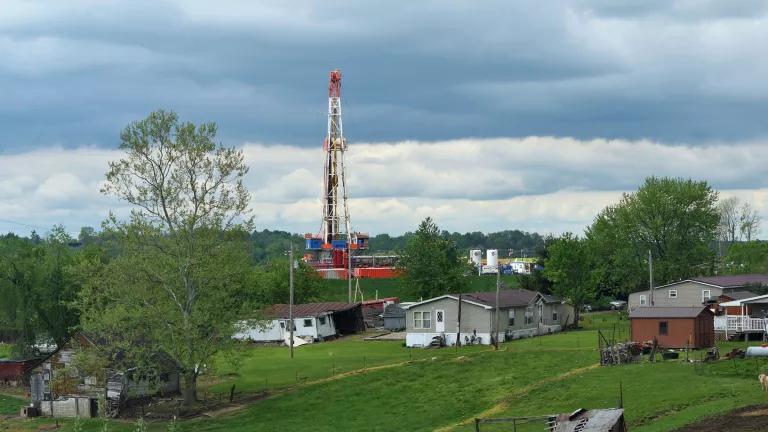The Latest Fracking Science Finds More Serious Health Risks
It’s time for Congress to hold the oil and gas industry accountable and close the fracking loopholes.

A fracking rig near homes in Beaver, Ohio
Ted Auch/FracTracker
Five bills were recently introduced in Congress to rein in harmful aspects of fracking that have been exempted from federal health and safety regulations. NRDC has been working since 2005 to close these loopholes in our bedrock environmental laws, including laws that are intended to protect people from drinking water contamination, toxic waste, and toxic air pollutants. These five bills are collectively known as the “frack pack” and have been sponsored by Members of Congress from around the country.
A thorough explanation of these loopholes can be found in NRDC’s 2007 report on the subject, Drilling Down. There are additional gaps in federal regulation of oil and gas exploration and production. Several of these are discussed in NRDC’s 2021 report, A Hot Fracking Mess, which focuses on gaps in the regulation of radioactive material released into the environment by oil and gas operations.
While fracking and its dangerous impacts haven’t been in the news as much in recent years, that doesn’t mean that the harms to human health, the environment, and public safety have gone away. To the contrary, scientists continue to learn more about the serious risks of fracking operations, particularly for those who live nearby.
This post highlights eight peer-reviewed scientific publications from just the last two years that identify negative health effects associated with living in fracking regions across the country. The health impacts include leukemia in young children, low birth weight and pre-term births, childhood asthma, and earlier deaths in older people. These important papers add to the thousands of other publications already listed in the Repository for Oil and Gas Energy Research (ROGER) and the Compendium of Scientific, Medical, and Media Findings Demonstrating Risks and Harms of Fracking and Associated Gas and Oil Infrastructure:
A 2022 paper in Environmental Health Perspectives estimated that Pennsylvania children who lived near a fracked oil or gas well during their early years, or whose mothers lived there preconception, had approximately two to three times the odds of developing childhood acute lymphoblastic leukemia compared with children who lived farther from a well.
A 2022 paper in the Journal of Health Economics found that shale gas wells are associated with increased preterm births and low birth weight: “drilling near an infant’s public water source yields poorer birth outcomes and more fracking-related contaminants in public drinking water.” New wells within one kilometer of a public drinking water source were associated with an 11-13 percent increase in preterm births and low birth weight in infants exposed during gestation.
A 2022 study in Nature Energy found that people aged 65 and older living near or downwind of fracking operations in all major U.S. fracking regions are at higher risk of early death compared with elderly individuals who don’t live near such operations.
- A 2023 paper in Environmental Pollution found that fracking operations from 2014 to 2021 continued to use dangerous chemicals associated with serious health effects. In these years, 62–73% of all fracking chemical disclosures included at least one harmful chemical. Researchers found almost 20,000 instances where the chemicals were used in high quantities.
- A 2023 journal article in Environmental Research: Health found that oil and gas air pollution in 2016 resulted in significant health impacts that year, including “410,000 asthma exacerbations, 2,200 new cases of childhood asthma, and 7,500 excess deaths, with $77 billion in total health impacts.” Areas with heavy oil and gas activity saw the most impacts, but there are also related health impacts in downwind states such as Illinois, New York, and Georgia.
- A 2022 article in the American Journal of Industrial Medicine by researchers from the National Institute for Occupational Safety & Health found that oil and gas workers are at risk from motor vehicle crashes leading to work-related fatalities. More than 60% of surveyed workers work at least 12 hours per day, plus they have an average commute of almost two hours.
A 2023 working paper from the National Bureau of Economic Research found state fracking chemical disclosure requirements are associated with significant declines in the use of hazardous fracking chemicals and better water quality. The researchers concluded that disclosure requirements lead fracking companies to change their practices and protect water quality.
- A 2023 report from FracTracker Alliance found that Colorado oil and gas fracking companies doubled their use of fresh water over the last 10 years (from 5 billion gallons in 2013 to more than 10 billion gallons in 2022). Water used per well went from an average of 2.7 million gallons to 10.9 million gallons during that period. This water is permanently removed from the hydrological cycle, a dangerous trend in times of increasing and severe drought.
The science is clear: fracking harms human health. There’s no justification for continuing to allow fracking companies to avoid the science-based protections in our fundamental environmental laws—protections that apply to other industries. It’s not only an environmental disaster, but also a huge financial giveaway to companies who continue to get rich thanks to taxpayer handouts. It’s time for Congress to hold the oil and gas industry accountable for their messes and close the fracking loopholes by passing this long-needed package of bills.



